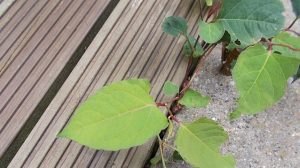
Japanese knotweed is a plant that can tear through buildings, paving and roads. It is notoriously difficult to clear and if you allow knotweed to spread and grow on to another person’s property you could be prosecuted.
Brought to Britain because of the beauty of its red stems and deep green leaves it is now causing damage across the country costing an estimated £150 million a year to treat.
Japanese knotweed can grow 20cm a day and can cause damage to your house’s foundations, drainage systems and walls as it grows rapidly seeking out moisture.
How to spot Japanese knotweed
If you are unsure if you have Japanese knotweed on your property Defra advises that you look for:
- fleshy red tinged shoots when it first breaks through the ground;
- large, heart or spade-shaped green leaves;
- leaves arranged in a zig-zag pattern along the stem;
- a hollow stem, like bamboo;
- dense clumps that can be several metres deep;
- clusters of cream flowers towards the end of July that attract bees;
- it dies back in the autumn, leaving brown stems.

As its name suggests it is native to the Japanese volcanic landscape. The climate and regular deposits of ash would keep knotweed plants small, while the plant survived thanks to energy stored in its deep root system. In Britain, without these impediments, it grows unabated.
How to remove Japanese knotweed
We recently found Japanese knotweed in a garden backing onto a railway line in south-west London (see picture).
To remove it you have several options:
- Dig it out: Digging out Japanese knotweed is a possibility but you leave any trace of its deep root system at your peril – it takes just 0.8g of root for a new plant to grow again.
- Feed it to bugs: Experts have introduced a Japanese bug, aphalara itadori, to the UK that feasts almost exclusively on knotweed.
- Kill it with chemicals: You can turn to chemicals, especially treatments containing glyphosate, but be warned, it can take up to five years’ treatment to finally be rid of the plant.
Any treatment could cost thousands of pounds and we would recommend you seek advice before proceeding.
